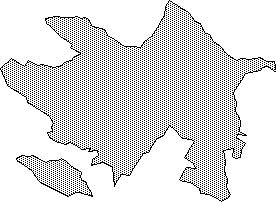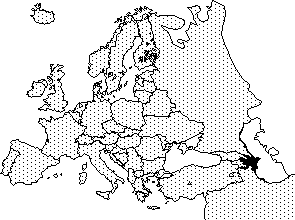[Front page] [Contents] [Previous] [Next] |
Management of Contaminated Sites and Land in Central and Eastern Europe
Azerbaijan
Country Characterisation


Background
Unit |
Total area |
Agri- cultural areas |
Peren- nial plants |
Pas- ture areas |
Wood- land areas |
Swamp soils |
Floo- ded soils |
State reser- ves |
Protec- ted areas |
||||
In % |
- |
51,4 |
2,4 |
27,8 |
11 |
0,3 |
3,9 |
2,2 |
1,0 |
||||
In km2 |
86415 |
44469 |
2073 |
24023 |
9486 |
227 |
3338 |
1912 |
887 |
||||
| Figure on total area from UN/ECE, 1998. | |||||||||||||
Population |
Population density |
Annual pop. growth |
Life expectancy at birth Male Female |
||||||||||
1000 |
per km2 |
% |
years |
years |
|||||||||
| 7632 | 88 | 1,20 | 67 | 75 | |||||||||
| Figures from UN/ECE, 1998, and POPIN, 1999. | |||||||||||||
Legal and Administrative Basis
Definition of Contaminated Sites and Land
There is no specific definition for contaminated sites and land.
Legislation
The Government and the Parliament of Azerbaijan have adopted a number of laws and standards during the past few years. In 1998 the Government approved a national environmental action plan which primarily is aimed at the restoration of land contaminated by oil products. The plan was elaborated by the State Committee of Economy together with the World Bank and with participation of various ministries and departments as well as relevant specialists.
A second project carried out in 1998 deals with the management of toxic and hazardous waste. This was also made in co-operation with the World Bank.
Besides this, the republic has also joined the UN convention on struggle against desertification. One point of this convention is also dealing with the chemical degradation of land. A national programme for the republic on the struggle against desertification will be made in the near future.
Implementation of Limit Values
No data available
Responsible Public Authorities
The main institutions responsible for control on soil conditions are:
| The State Committee on Ecology and Nature. | |
| The State Land Resources Committee. |
Registration
Up to now there are no inventories on contaminated sites.
Characterisation of Soil and Groundwater Contamination
Sources of Soil and Groundwater Contamination
The problem of land contamination by pesticides and mineral fertilisers is very important for the republic. During the past, more than 300000 tonne of mineral fertilisers and 40 – 60000 tonnes of pesticides (about 100 different kinds) were used within the agro-industrial complex. The mean loading of pesticides in the cotton growing regions was 25 – 30 kg/ha per year, and for vineyards was 150 180 kg/ha per year. The pesticide use has been reduced. However, the quality of these has been lowered. Formerly, the republic received pesticides from centralised USSR departments. Now the individual farms get the pesticides from small companies e.g. selling low quality products.
Besides this the, the main sources of soil contamination are oil products, oil processing, chemicals in general, mining, and metallurgy.
Contamination with heavy metals represents a problem. The main sources of heavy metal accumulation in the soil are industry emissions, waste and traffic emissions. In general, the contents found for heavy metals exceed the index for average lithosphere about 8 times for lead, 2 times for nickel, 50-60 times for zinc, and 10 times for copper. The high contents may among others be explained by the use of copper vitriol and zinc against pests. Long term monitoring have shown that the crop capacity of fields decrease about 20% due to traffic emissions in a distance of 1 m from a road.
Mining activities are also among the factors that cause soil and land contamination. In the republic, there are more than 300 mineral deposits being exploited. About 200 of these are mined by the open pit method, which is cheaper an more effective compared to underground methods, but also causes more environmental problems.
Furthermore, areas contaminated by oil products represent a special problem in Azerbaijan. It is estimated that areas contaminated with oil products equal approximately 11000 ha. Until today, none of these have been restored. Furthermore, there is a considerable loss of land connected to the construction of pipelines (4 ha per 1 km).
Number of Registered Contaminated Sites / Contaminated Land Areas
There is no estimate on the number of contaminated sites.
The following estimates have been made on contaminated areas, saline soil areas etc.
Unit |
Total area |
Saline soils |
Erosion soils |
Oil contaminated areas |
Other contaminated areas |
In % |
- |
13,8 |
42,8 |
0,16 |
0,18 |
In km2 |
86415 |
11954 |
36957 |
140 |
160 |
Investigation Methods
Identification of Potentially Contaminated Sites and Areas
No data available
Investigation of Contaminated Sites and Areas
No data available
Facilities for Contaminated Soil
Handling and Treatment of Excavated Contaminated Soil
Up till now, no facilities exist for treatment or proper depositing of contaminated soil.
Measures Used by Remediation of Soil and Groundwater Contamination
Up till now, no remediation of contaminated soil and groundwater has been performed.
Financing and Liability
Investigation and Remediation Activities
No data available
Legal Requirements re. Polluters and Site Owners
No data available
Scope of the Problem
Scale of the Problem and Handling Costs
No data available
Priority in Relation to Other Societal Problems
No data available
Illustrative Cases
No data available
References
Information provided by Javanshir Ismaylov at the State Committee of Ecology of Azerbaijan. April 8, 1999.
Ad Hoc International Working Group on Contaminated Land (1998). Ad Hoc CEE Forum on Contaminated Land. Report of the Warsaw Meeting, September 18, 1998. Report from the Swiss Agency for the Environment, Forests and Landscape.
POPIN (Population Information Network) (1999). The Demography of Countries with Economies in Transition. At gopher://gopher.undp.org/00/ungophers/popin/wdtrends.
UN/ECE Statistical Division (1998). Trends in Europe and North America. 1998 Statistical Yearbook of the UN/ECE. At http://www.unece.org/stats/trend/trend_h.htm. Based on figures from 1994 – 1997.
[Front page] [Contents] [Previous] [Next] [Top] |